Down to Earth
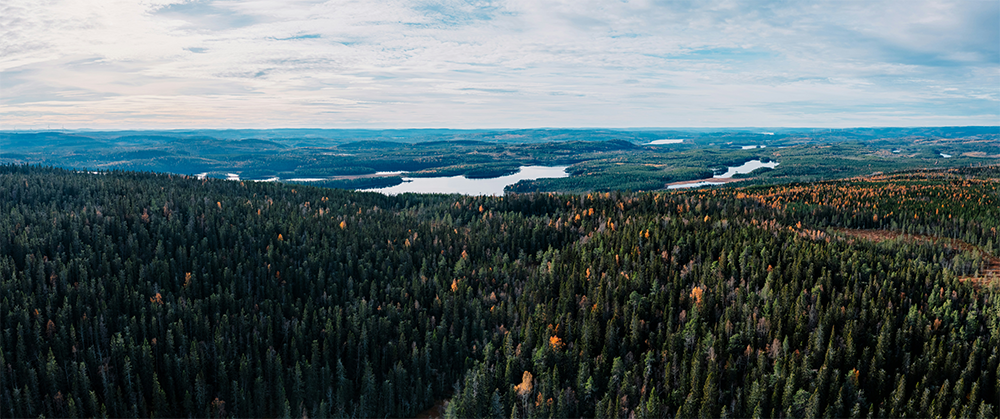
Forests are under a lot of pressure to deliver material, while pests and storms are an increasing risk. The base narrative in society is that the soil is there for us to utilize it, says Kristiina Lång, Research Professor, Natural Resources Institute Finland (Luke).
Introduction
The ground we stand on is all we have. Throughout history, it has provided us with everything, as the foundation of civilization. In this article, we try to lay an ear to the ground, listening to the knowledge that grows from the soil that feeds us. Cultivable soil is a scarce resource, at the intersecting point of many interests. This article will focus on the underrepresented voice of our land use in architecture and planning in the Nordic context.
We find ourselves in a constantly changing landscape of politics and policy. The current state of Europe against a background of international conflicts, ongoing crisis and wars, affects our collective ability of addressing crucial questions of sustainable development and mitigation of climate change and global warming. Changes in land use are the main reason for loss of biodiversity and the biggest driver of climate change. Meanwhile, territorial conflicts show how much land is valued on a national level. The paradoxical relationship to land is due to how it relates to power. The loss of land is the loss of power, although we need to reassess this logic and go much deeper into the ground, beneath the surface condition of land assets.
In order to understand the complexity of ecosystems and how they nurture us as humans, we need new models of knowledge. The ability to visualize is a key competence in relation to research and practices of change, as exemplified in these interviews. It is not just a matter of visualizing complex systems in the forms of diagrams or infographics, but also to visually manifest change itself. “Before- and after” images are powerful drivers of understanding of potential change, affirmed by the architects interviewed here. Demonstrating alternative use by creating a vision as a method established in the practice of planners and architects, is as potent in the fields of research and policymaking.
Visualization is the key to understanding the scale of human interventions. As this text is written, Norway is roaring with debate in the wake of a documentary produced by the Norwegian journalist Mads Nyborg Stöstad.
We cannot afford to lose ground.
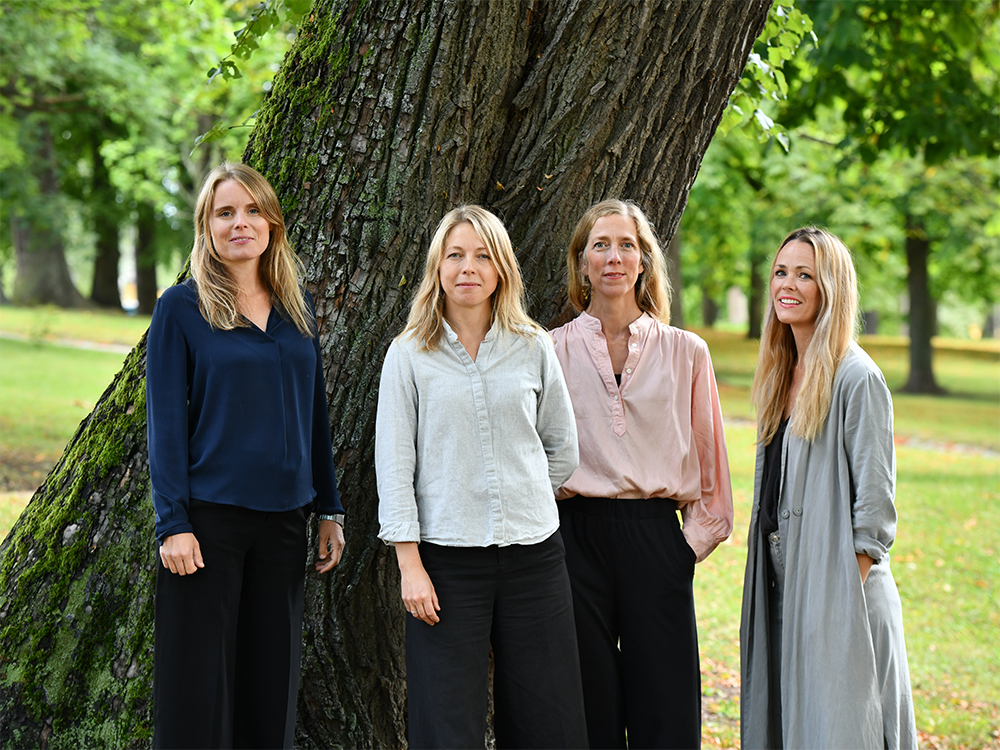
The perspective of a nature-based architecture and urbanism
Nature-based urbanism is about integrating urbanism with nature-based solutions. Gaia arkitektur starts off from the perspective of coexistence between culture and nature. Land use becomes the starting point in an aim to restore the balance in this coexistence. Marta Bohlmark and Ulrika Stenkula are architects and founders of Gaia, where they, together with two additional partners and collaborators, Ania Öst and Pi Ekblom, work with urban/rural development within the framework of water, forests, and the life conditions of humans and other living beings. They bring with them extensive experience from large-scale architectural firms and academia.
Their professional experiences have evolved into a desire to shift the perspective from the simplification that humans alone are at the center whilst nature is the resource at hand, as Ulrika Stenkula describes it:
– It became increasingly clear that we as actors within the built environment sometimes did not work with nature. Our projects focus on the green-blue structures as the foundation for life. When we start a project, we begin with the understanding of the prerequisites of the land. We map out the systematic flows and relations, both through GIS, history, site observations and interacting with the local community. We identify the points where there is lack as well as high values. We aim for a synergetic approach.
Our projects focus on the green-blue structures as the foundation for life.
Procurements and requirements
Gaia’s practice involves mapping the existing stakeholders systematically. Understanding incentives and needs connected to the site and the development is essential. Ulrika Stenkula emphasizes that procurements and requirements create incentives and must be based on prioritizing regenerative development and resource efficiency.
– We must listen closely to the inherent conditions of the land, the earth. Today we see how the official documents present plenty of regulatory statements with various conflicts of interest. The economic policy must align with the environment. Historically many human concepts have contributed to the division between humans and nature. Modernism is one expression that has influenced the field of architecture heavily. This divide is a way of thinking that has prevailed, where the landscape is a place from which we extract resources like energy and food. We now collectively see the consequences of this dualism. For the first time in history, we are globally intertwined, and the effects are global, thus massive.
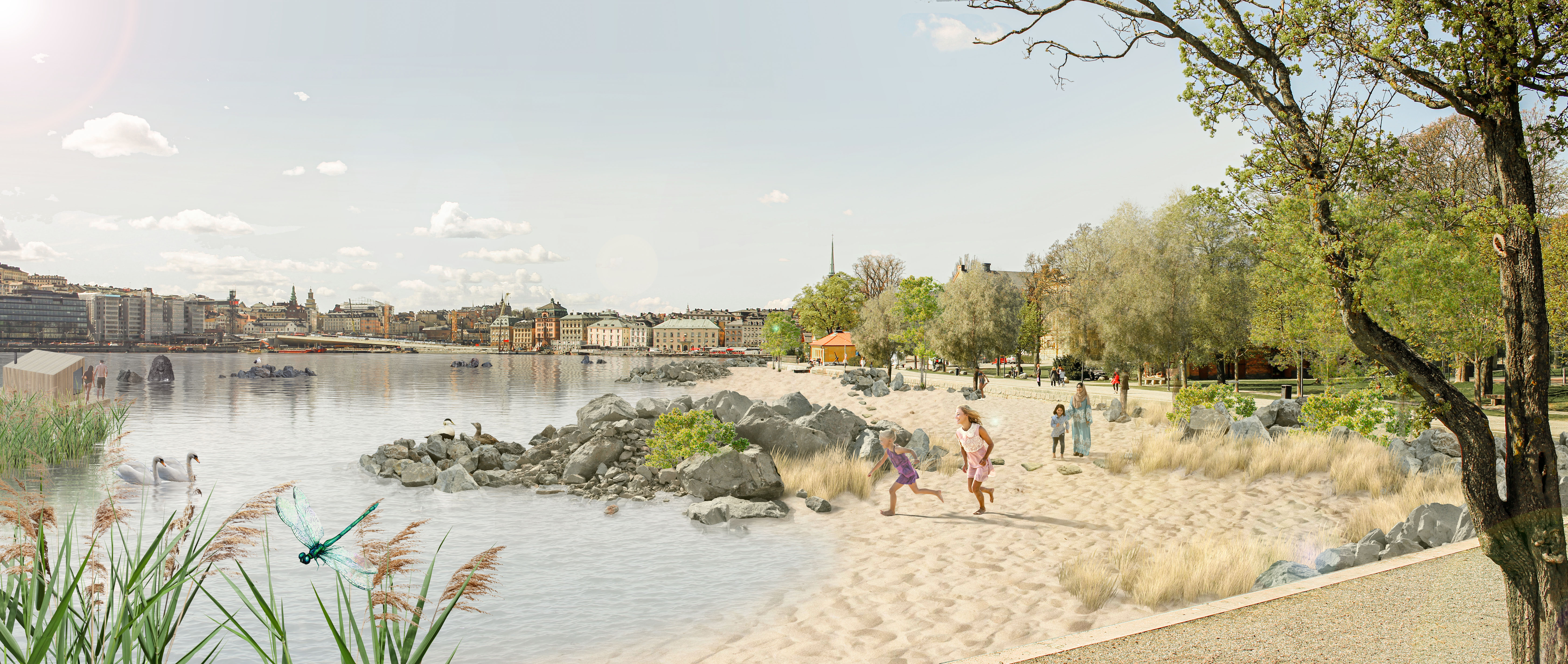
Render of Skeppsholmen, Stockholm
Long-lasting architectural practices
Gaia believes only regenerative practices will prevail in the long run. Their work requires both new methods and processes, and they also see the need for new roles within the field.
– Working as architects in our day and time has resulted in projects that involve recreating nature, says Marta Bohlmark. The methods and processes that we develop work as a general framework and the parameters are always site specific; thus, the result manifest as diversity, just as nature works. We use the experience of beauty as an indication of a viable project. We are interested in exploring how these – often conceptualized terms – such as beauty, in essence could very well be a phenomenon interlinked with sustainability.
In their practice as architects, Gaia seeks to recreate structural conditions for natural processes, using the function and grammar of nature itself. An example of this is the creation of a lagoon in Stockholm inner archipelago where the predatory fish are supported through created reeves. This action is part of supporting the endangered eco system in the Baltic Sea. Marta Bohlmark explains the methodology:
– This is not the same as remediation or direct solutions to increase the land's capacity. It requires time and careful research to find the right solution. Instead of, as architects, providing an answer to a question from an industrial perspective, we base our methodology on finding a question that will address an opportunity (financial investment is one) based on finding synergies, addressing long term needs and thus long-term values.
Practice-based research as a method
Gaia’s projects often start with practice-based research. Posing the right question is essential to finding the relevant answer in times of transformation. The research projects then act as a base for prototypes and projects that implement the findings.
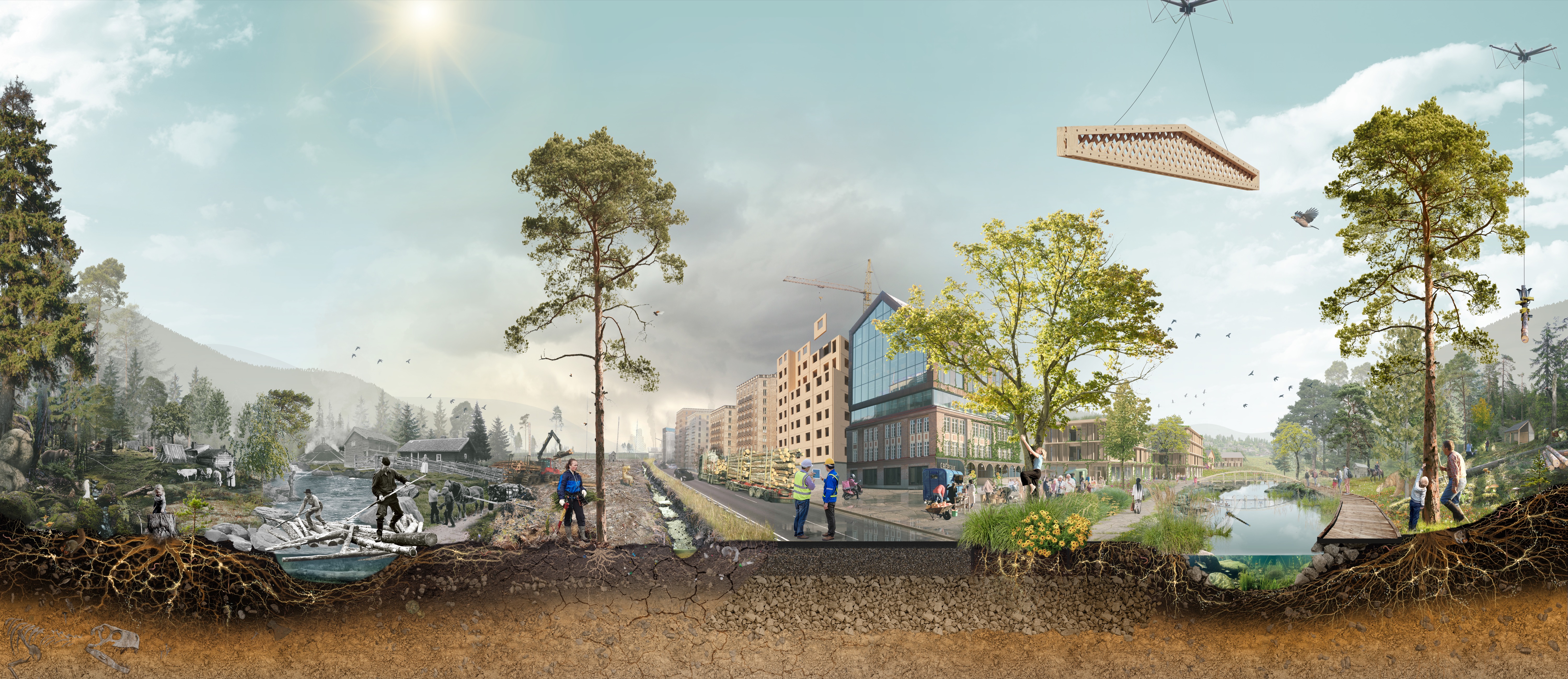
Picture from the research project Living Forest Living Society – our relationship with the forest; past, present and future.
Gaia has built platforms around three research areas: the forest, the water and the rural living environment. Among these, Gaia’s research-based project MASSA has gained interest and has become somewhat of a growing movement. The methodology involves managing enormous amounts of stone from infrastructure projects, such as the ongoing subway construction in Stockholm where 25 million tons of stone will be handled. That corresponds to convoys of trucks transporting the stone residue out of the city, putting pressure on the city in many different ways. Marta Bohlmark explains the strategic vision.
– Transporting residue accounts for 40 percent of heavy traffic today. At the same time several of the excavation sites for the construction of the subway are located near water. We propose a strategic design vision for six sites with a high recreational value in the inner archipelago of Stockholm. With water transport and assigned water restoration projects these challenges can be turned into opportunities.
– Life cycle calculations need to account for every aspect of a project's consequences to be valid, emphasizes Marta Bohlmark. Legal agreements that sublet responsibility to another actor, are only a theoretical construction. Maybe the responsibility needs to go even further; if you gain from an action, you inherit responsibility. If there is a lack of that perspective, economic gains will appear from the very slack and inefficiency that the society aim to prevent. Creating business models that rely on upholding slack can be more than wasteful, sometimes destructive. As an example, we should maybe not pay to get rid of stone residue and then pay to get it back when building? At the same time trucking the stone forth and back on our roads across the country.
Reasonability for long-term restorations
Great efforts are also being made along the line. The city of Stockholm has created a logistic center for stone residues, and some of the excavated stone is transported on water, to be used in the city’s own projects.
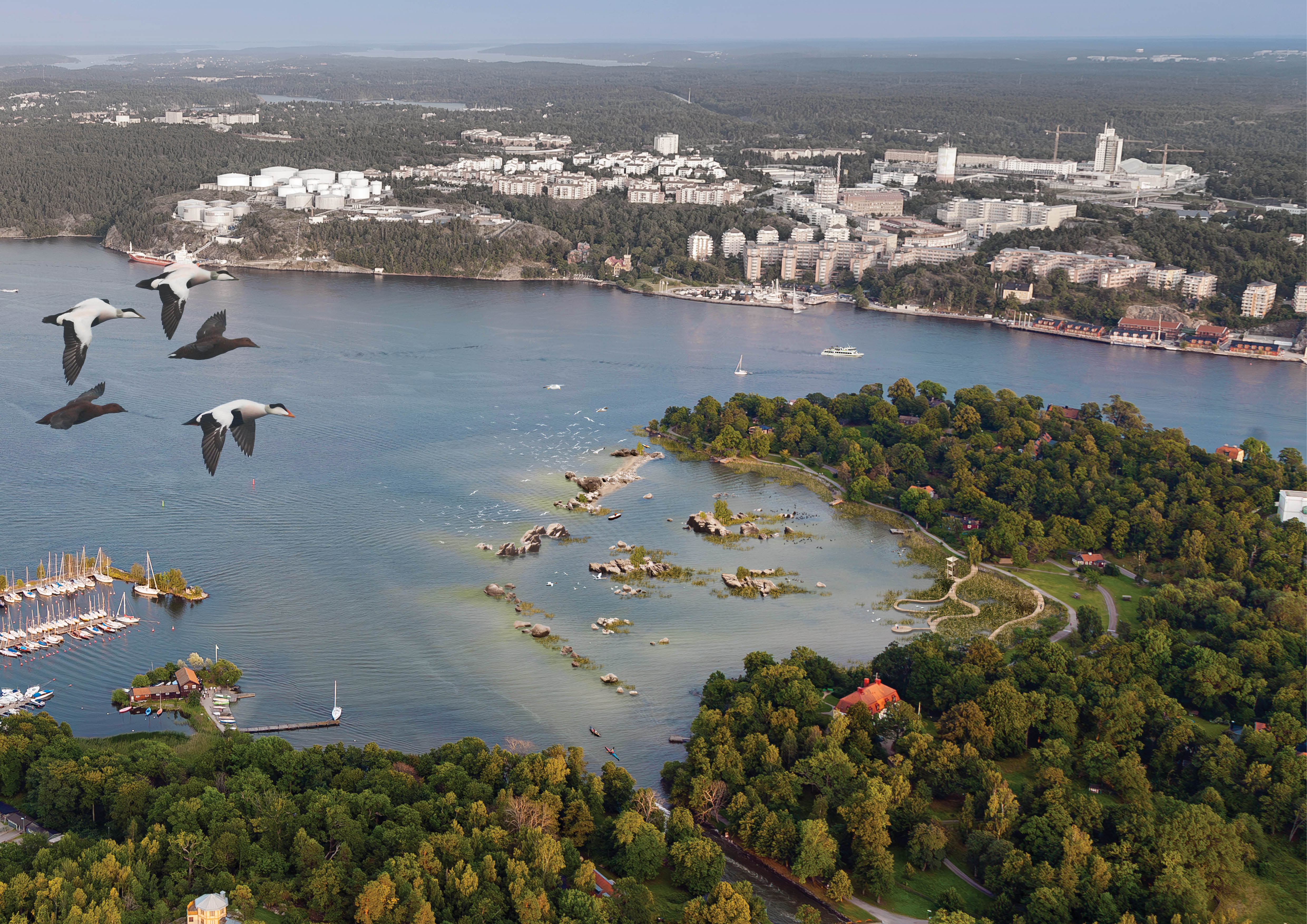
Vision of a new lagoon in Stockholm inner archipelago
– We propose quite small measures compared to the enormous logistics and cost of removing masses between sites, says Marta Bohlmark. One issue in these initiatives is the mandate; who is responsible for these long-term restorations? When the gain is for everyone, maybe everyone is responsible. But more often the conclusion maybe is that no one is responsible. We see this as one way of taking the responsibility, by contributing with prototypical examples. It needs also to be said that there are many occasions on these pilot projects where the initiatives can be put to a halt; it only takes a little uncertainty and doubt during a meeting, and everything is at risk of being struck down. The lagoon has prevailed as a valid proposal with great ecological potential and will be submitted for building permits together with the landowner Royal Djurgården.
Examples that manifest healing
We see how we can contribute by showing examples of how these initiatives can actually be manifested in reality. To scale up these prototypes’ organizational structures. We drive the issue in our projects by creating actor networks, which allows us to work with more complex and larger areas – this is important because we need to heal entire environments. Not everyone wants to engage in actor collaboration; it is quite a demanding process. It's exciting times for architects, where we can act in new roles, not least by using our expertise in creating shared visions.
Gaia produces the vision images needed to show alternatives, such as illustrating how a shoreline can be designed in the city where there has been a quay for hundreds of years. Especially in research, images are needed, as visualizations are powerful communication tools.
– As an architect, it's natural to observe an environment and at the same time see the possibilities; it's a trained gaze – not everyone has this ability, even if architects tend to forget that it is an acquired competence to see spatial opportunities with the eye of your mind. With powerful images, we can help create a shared vision, says Marta Bohlmark. We facilitate the actor network sharing the vision through various methods. We believe that all actors need to connect to the actual place.
– A place that you have experienced and created a relationship with you naturally care for as an empathetic being. We are the water, and we are the forest and the land, says Ulrika Stenkula as a summary.
– We believe that these new processes that reconnect us to the landscape are essential, asserts Marta Bohlmark. In these projects, a broad range of disciplines are involved and extensive work with local communities. There is an impressive amount of knowledge in our society. However, this knowledge needs to be connected in efficient and seamless ways. It is not easy, but it’s amazing when it works. A few people can make a tremendous difference, and especially when they become connected.
It's exciting times for architects, where we can act in new roles, not least by using our expertise in creating shared visions.
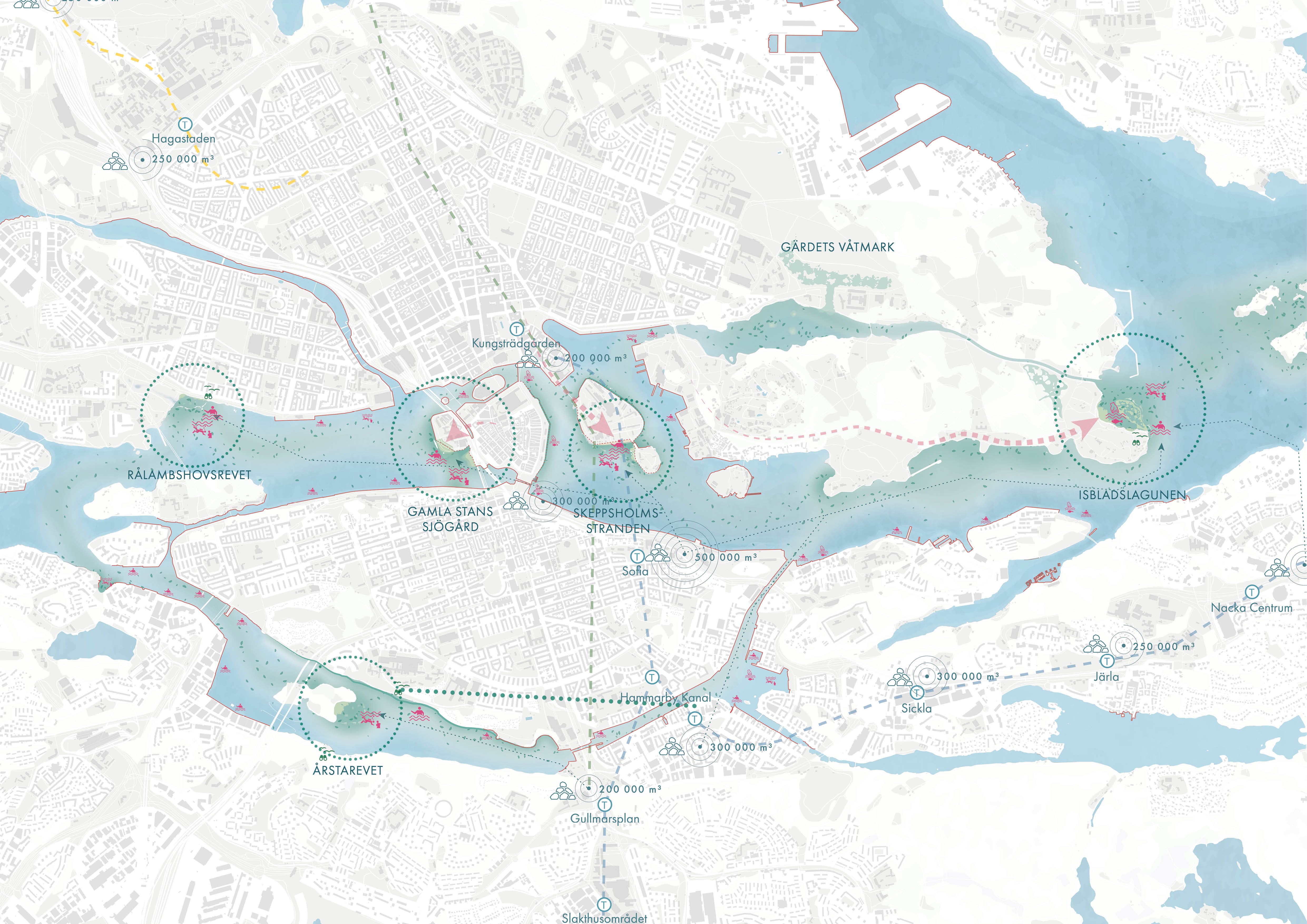
Strategic map
Join forces with nature and reconnect
Gaia sees challenges as engaging opportunities. As architects they can construct platforms that connect broad and inspired knowledge we have an important possibility.
– With inspiration we can develop our landscape and create new awe-inspiring experiences. To us it is a simple truth; join forces with nature and reconnect to the earth under your feet, says Marta Bohlmark. The MASSA project gathers participants from the administration of Stockholm dealing with infrastructure, logistics, water quality and fish, as well as academia and expertise in marine ecology, construction, heritage, architecture and art and extensive community interaction. These actors have an individual ability to both understand their specific contribution and the holistic living environment we are aiming to create.
On March 7, the Bifrost bridge was inaugurated in Uddebo outside Gothenburg, made of 96 percent wood. The bridge is the result of a research project carried out by Gaia in collaboration with Timber bridge specialists, Funkia landscape architecture, KTH and the City of Stockholm. Photo: Timber bridge specialists
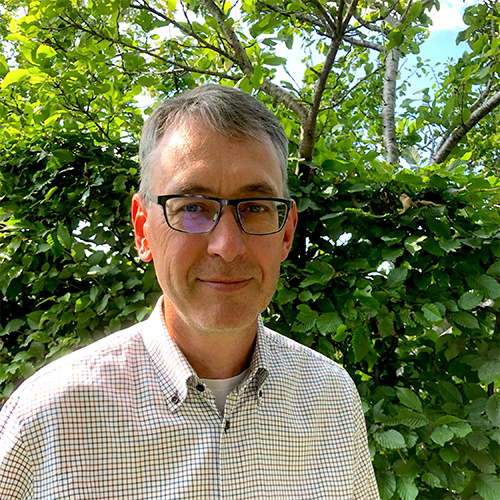
Ground Values
Anders Larsson (Dr) is a researcher and teacher at the Department of Landscape Architecture, Planning and Management, SLU Alnarp. Anders is a member of a number of Swedish and international organizations, among others the Royal Swedish Academy of Agriculture and Forestry (KSLA) and ECLAS (European Council of Landscape Architect Schools, Executive Committee).
– As a young architect, I thought I would follow the path to become the great “Designer”, but by way of amazing supervisors and teachers, I set off on the path to landscape planning in relation to agriculture. It is not a huge academic field, but now we see an increase in interest from our Master students in the subject area.
– I have a feeling that our self-image in Sweden is that we are doing just fine in our national green transition work. This is interesting, because we seem to have a constant dead angle in our perception of Sweden as a very moderate nation, when in fact we are extreme. In comparison with other nations, we are almost off the chart in some questions. Our relation to natural resources is one of these extremes. If the state would compensate for placement of windmills, as the practice is in Denmark to offer 20 percent partnership to the local community – in Sweden this is an option, not at all mandatory. In Piteå, a foreign energy company could reap full profit without any compensation to the local community. This has been practiced to a point where few or no locals will say yes to windmills in their territories. Still, with all the exploitation going on, uncritically, I cannot see a demand for analysis, research, and calculations to back up our regional layout plans. The thinking at municipal level seems to be “just keep on keeping on in the name of growth and we will be successful”. And if a global actor comes along and wants to set up a warehouse for servers, a battery factory or a logistical center, municipalities accept them gladly and offer all kinds of discounts on local resources, even if there are very few work opportunities in the offer.
Land use: Artificial land cover 2018, square metres per capita
Source: Office of Germany (Destatis), 2024.2 Graph: Federal Statistical Office of Germany (Destatis), 2024. Source: Eurostat.
EU as a driving force for land protection
What can we do in the face of this lack of foresight?
– There are plenty of examples internationally that could readily be applied in Sweden, if we would be interested in protecting future resources. Compared to the German system, where there is a regional policy that any industrial establishing should be made in existing industrial areas, anywhere outside of existing industrial grounds will be subject to large costs on the entrepreneurial side, called “Eco-accounts” and in rural areas there is a protective “belt” around villages where no industrial establishment is accepted, says Anders Larsson and continues to describe the particular conditions and attitudes towards land use in the Swedish context. What can we do to mitigate the conflicts of goals?
– In Sweden, everyone refers to PBL (The Swedish Planning and Building Act), yet land as a resource is in effect rather unprotected in our country. We have a whole variety of terms that make us believe that we have a solid protection of the land; we have areas declared as “national interest”, “federal interest”, “particular civil interest” and more – nobody really understands the difference. And it seems that whatever term of protection that is put on a piece of land – it can readily be overruled by some compensatory action somewhere else. Our legal foundation is based on exploitation and extraction, and the Environmental Code is a bit like a sticker on the surface. I think we should turn the legal protection to its other end and build from the ground up with a sustainable approach.
– When I worked for the Swedish Road Administration, I became aware that EU is a driving force in protection, while Sweden as a nation has a regressive attitude in favor of exploitation. The EU is a lot tougher, simply because they have a large-scale overview of the land use of the EU. If we do not act now, I think we will have a much harder time to transform. We need to get our politicians to understand that either we engage in incremental adaptation, or we will have to deal with a transitional chock in the future.
Our legal foundation is based on exploitation and extraction, and the Environmental Code is a bit like a sticker on the surface.
The illustration shows the amount of shopping centers per 1000 capita
Source: ICSC 2014 and Eurostat 2014
The dissociation between self-image and dominating practice is bad enough for the transitive ability. Does Sweden have any examples of municipalities who adopt a more futureproof strategy?
– The municipality of Jönköping is the first in Sweden to sign a protective law for agricultural soil. Behind this decision lies many years of political discussion to reach a political agreement between all political parties. Jönköping has thus shown what can be done on a municipal level right now, within the framework of the present legislation.
Measuring the values?
The most common question that Anders Larsson gets is “what is the soil worth”:
– What is the future value of cultivable soils? How do we calculate the value of arable land fifty years from now? My boring answer is that – it depends. There are no calculation models. It depends on how much soil is protected around the globe. The value depends on how the condition of the soil is kept – if it has been subject to compactation, flooding, droughts, pests – there are a number of factors. What we do know is that we need to engage in regenerative agriculture and return more organic material to the soil or they will become infertile. The UN report on land use lifts the questions to a higher level, not just asking how much produce could be harvested from a patch of land, but regarding every level of use, including water retention and flood delay and other large scale ecosystem services. A fatal mistake is that land is not included in the life cycle analysis model for the built environment.
With the EU as the stronger driver of regenerative strategies, what does Anders Larsson think of the potential for more collaboration in the Nordic region?
– Our natural environments differ greatly in scale and constitution, from the rural Denmark to forestry in Sweden, Norway and Finland, but of course we can learn from our neighbors. But if we are serious in studying the protection of agricultural soils, then we should look at for example Germany or the Netherlands, densely populated nations with a high percentage of agricultural land. Scandinavians have placed investments in Baltic land. I learned that 10–15 percent of the Baltic region is owned by Nordic companies – perhaps as a future bond, since the current production value of the soil is lower than in our countries. This, if anything, tells us that we are planning for an insecure future. And when facing insecurity, the best thing to do is act with great caution.
What we do know is that we need to engage in regenerative agriculture and return more organic material to the soil
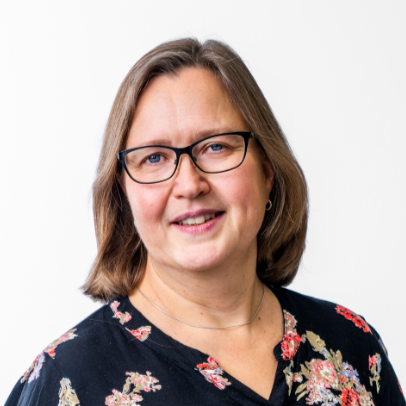
The perspective of a soil scientist
Kristiina Lång is a research professor of agricultural greenhouse gas mitigation at the Natural Resources Institute Finland, where she studies ways of improving the sustainability of land use in agriculture. Her studies focus on mitigating greenhouse gas emissions of cultivated peat soils by developing value chains involving biomass production in rewetted peat soils.
– I am an environmental scientist concentrating on soil issues. My research career started with greenhouse gas emission measurements. I have also worked on policy advice on climate mitigation in land use. Then I realized that these are very slow routes to changing the world, so I turned my focus to climate change mitigation in the land-use sector by biomass production on rewetted peat soils. Peat is originally a thick layer of organic matter that has not decomposed since it has been preserved under water. Peatlands are ecosystems that support biodiversity and serve as carbon sinks as long as they are wet. Drainage starts the process of peat decomposition that leads to high greenhouse gas emissions. Peat releases huge amounts of stored carbon dioxide and nitrous oxide when it is cultivated, about 30 carbon dioxide equivalent-tons per hectare if we use them in agriculture. Peatlands used in agriculture emit annually as much greenhouse gases as passenger cars in Finland. When rewetting drained peat, the water table is raised to retain the peat. It can be left to revegetate with wild vegetation or used for biomass production of a moisture-tolerant crop. Biomass production on rewetted peatlands (paludiculture) provides double benefit: emission reduction from soil and substitution of unsustainable materials.
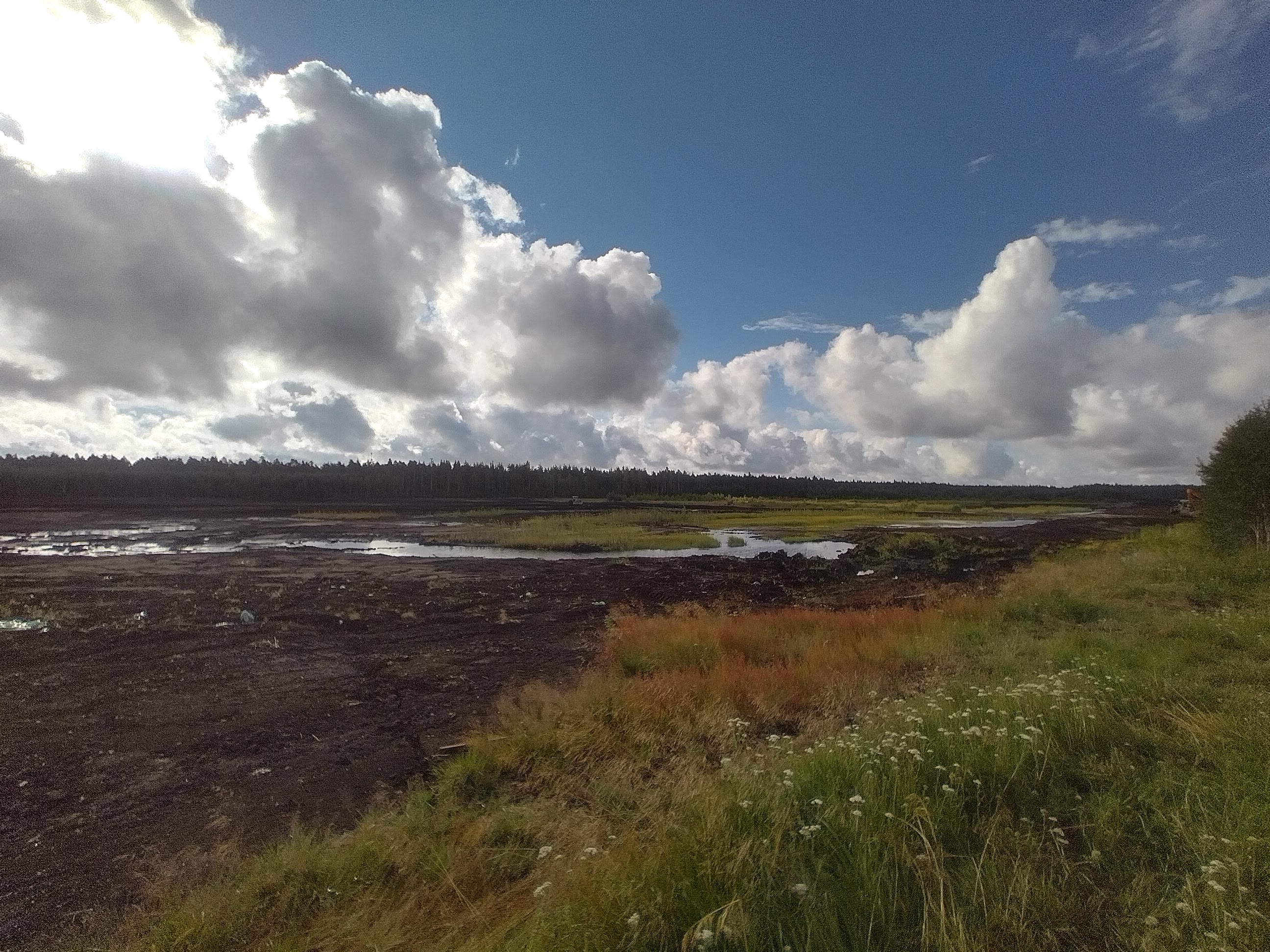
Peatlands are ecosystems that support biodiversity and serve as carbon sinks as long as they are wet. Drainage starts the process of peat decomposition that leads to high greenhouse gas emissions. Peat releases huge amounts of stored carbon dioxide and nitrous oxide when it is cultivated, about 30 carbon dioxide equivalent-tons per hectare if we use them in agriculture. Biomass production on rewetted peatlands (paludiculture) provides double benefit: emission reduction from soil and substitution of unsustainable materials.
Replace fossil materials with novel biomass types
Kristiina Lång studies what kind of plants can serve as biomass, not if but when we have to replace fossil materials:
– Cattail, reed and grasses are high yielding crops that can be used for many kinds of industrial purposes. If we want to be climate neutral, we need both reduced emissions and a strong carbon sink by maintaining the forests and peat lands. Forests are under a lot of pressure to deliver material, while pests and storms are an increasing risk. We need to keep the options open, and for example the FIBSUN project studies how to use novel biomass types in construction, automotive and textile industries.
The Nordic perquisites and self-image
Kristiina Lång points at the Nordic self-image is quite elated in the field of sustainable development. We are making a lot of mistakes along the way, it seems. What is the situation of urban sprawl across fertile land?
– I think we are a bit careless in the Nordic countries because we have a lot of land area per person. In other countries like France, they have been wise enough to regulate for instance, where to place solar power panels – first choice is on roofs and parking lots, whereas here we often use agricultural or forest land. Regarding the issue of rewetting, we all face the same problems in the Nordics, where we have about the same amount of drained peat soil. Denmark has incentives in place to rewet half of their agricultural peat soils, a good enough strategy. Norway has also initiated a rewetting program. In Finland we are concerned because we have peatland that are neither used for food production, nor rewetted. We found 17 000 hectares of drained peatland fields in farms that do not produce food at all. In addition, there are tens of thousands of hectares in “middle grounds”, land that is not in active use, producing a lot of emissions but not producing food. In Sweden you have a better legal system to deal at least with estates of the deceased: according to the law they cannot own farmland for more than four years. Without a law like this, the government has no tools to guard the land use because agricultural policies reward landowners for owning the land; food production is not required.
If we want to be climate neutral, we need both reduced emissions and a strong carbon sink by maintaining the forests and peat lands.
The whole picture
Although the values are immense, there seems to be no one who has the whole picture of land use, nationally or indeed in the EU. Meanwhile, we in the Nordics continue to apply our consumer perspective on land, and the potential to strengthen the carbon sink of soils is not fully utilized. Kristiina Lång proposes communication strategies across stake holders, that could be applied on a national level:
– Our ministries should talk more to each other. Agricultural and forestry ministries are responsible for most of the regulation of land use. Ministries for Building and infrastructure, the Ministry of Environment, and the Ministries for Energy systems – all of these are related to land use. Then we need to consider the division of responsibility between the local municipality who decide on land use and planning, and provincial authorities giving other permissions – also they have tools to improve land use. Policy coherence should be improved – not only guiding us to the don’t but to the do’s in reducing emissions. Industrial policies could support land use policies by favoring companies who want to develop new methods of production and ways of using materials. We should have more uniform guidance from the government regarding how land use should be prioritized, for example when placing solar panels in the landscape. So, in order to use land in a smarter way – there should be guidelines for priorities of use in different land use situations: use natural soil only as a last resort.
Kristiina Lång adds an example on a successful communication strategy:
– In Finland, the authority implementing land consolidation started to inform landowners about the high greenhouse gas emissions of peat soils, in order to recommend the owner to restore such land parcels to mitigate the emissions. Taking action is optional, but a tool is now available to help the authorities to calculate effects of alternative soil management.
Our ministries should talk more to each other. Agricultural and forestry ministries are responsible for most of the regulation of land use.
Healing the ground
Finally, there is the cultivation of soil for the purpose of healing the ground:
– In the FIBSUN project we measure the ecosystem services soils perform. Soil remediation can be achieved by crop production as a way of taking pollutants out of the soil. Organisms learn how to take up pollutants, and how to degrade them. In extremely dry soils, in the Mediterranean for example, they can be too dry to use for cultivation – but if we get a draught-resistant crop to grow there the vegetation is able to restore the ability of the soil to retain moisture. For example, hemp is a versatile fiber plant with a high potential of remediating soil, and it does not require much water.
The more you study soil issues, it becomes clear that the situation is quite alarming. Do you think that we need to change the general narrative about soil and the use of the soil?
– The base narrative in society is that the soil is there for us to utilize it. Then we become surprised, in the image of the tragedy of the commons, that soils are over-used. We should be much more considerate before we start any intensive use activities. We have a pretty good knowledge about what destroys soil, and also how to avoid damage. Ecosystem services should have a prize, a monetary value, that society and consumers could pay more for sustainable options. Consumers should know more about the effect of soil use on the climate impact of products which is currently not fully included in life cycle analyses. This spring, we were close to a new EU law of land restoration that would have made a great difference. We might get that chance to vote for protection of ecosystems again. Either way, we need to keep faith in the democratic processes, and appreciate that EU is a strong driver in land-use questions.
The more you study soil issues, it becomes clear that the situation is quite alarming.
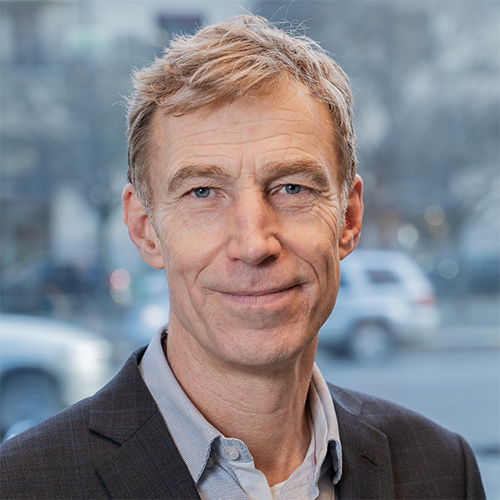
Governed by money instead of economy
Thomas Hahn is an Associate Professor and principal researcher, leading a collaborative research program for climate action and transformation with civil society organizations (FAIRTRANS).
Hahn's work on ecosystem services has resulted in an overview of the different approaches that we humans have towards nature. The outset for his research is that most people are largely unaware of the great value of the contribution to health and wellbeing that nature provides. Planning for and with ecosystem services is smart from the point of view of national economy, but this strategy is not included in the calculations and budgets in local land use decisions and politics on a municipal level.
Nature as a reservoir of raw materials
Thomas Hahn summarizes the overview that was developed for the study IPBES – Intergovernmental Platform for Biodiversity and Ecosystem Services:
– The first approach we can call Living from nature. From this perspective, we see nature as a reservoir of raw materials. It is not inherently wrong – everyone lives off of nature, but it is an extremely dominant view in our Western culture. We also see ourselves as Living in nature – here, nature is our living room where we feel at home, reinforcing our sense of belonging, which nature type we "come from" as individuals, something that gives us a sense of place and that we value for the recreational and social spaces that nature provides to those who visit, such as sailors, bathers, hikers, etc. We humans can also see ourselves as Living with nature, where we are a species among many others in an intricate ecosystem of which we are a part. This is an ecological understanding that requires a bit more understanding and interpretation from our side. Nature works very well as long as we don't become too greedy, then the balance disappears. If we live with nature, we need to understand the connections between human activities and biodiversity; agriculture, forestry, fishing. An approach that takes this connection to another level can be expressed as Living as nature, where we have developed a deep relationship, a spiritual dimension in the relationship with nature.
The outset for his research is that most people are largely unaware of the great value of the contribution to health and wellbeing that nature provides. Planning for and with ecosystem services is smart from the point of view of national economy, but this strategy is not included in the calculations and budgets in local land use decisions and politics on a municipal level.
Biodiversity and ecosystem services in the green transition
Thomas Hahn has been working on land use issues in relation to the green transition for the past eight years. He has looked at ecosystem services and how to protect them, and calculated so-called biodiversity offsets, where lost values are replaced by a land-exploiting company, such as in the construction of a mine.
– It should be known that compensation and replacement are not entirely accurate terms. Every ecosystem that is destroyed is unique. The order still becomes that 1) the mine is prioritized, and 2) it is decided that lost values on-site should be compensated for, for example, by preserving a forest area as a land conservation area, at the expense of 3) the industry, such as the forestry industry, which loses what cannot now be harvested in the protected area. Every project corresponds to their having to be less in another project. Those most affected are usually indigenous peoples and low-income earners in rural areas – those affected by mines, construction of wind farms without compensation, or tax technical solutions as they have in Norway.
The UN has launched the concept of No net loss of biodiversity and ecosystem services. The world's ecosystem services are to be restored, but how will this be done? Thomas Hahn sees clearly on the matter:
– There is no government that disagrees with this preservation, but in a society that is fully focused on growth – more mines, more land exploitation – the compensatory measure is shifted around the entire chain. For every zone that is to be preserved, there is an actor whose room for maneuver is reduced, but the total burden continues to increase because it is assumed that exploitation and extraction should still be allowed to occur.
For every zone that is to be preserved, there is an actor whose room for maneuver is reduced, but the total burden continues to increase because it is assumed that exploitation and extraction should still be allowed to occur.
Goal conflicts
To address goal conflicts and these layers of justice issues, are there solutions within our democratic processes or in increased knowledge?
– We have knowledge, but one must be interested in absorbing it. People want the municipalities to be able to govern more through the comprehensive plan, where certain areas should be marked as "occupied" by performing ecosystem services. If you seek help from experts such as limnologists who can show exactly which land areas are crucial for absorbing large amounts of water and preventing floods, then you can mark out that area in the comprehensive plan and let that ecosystem service serve as insurance for the future. Other experts can show where important pollination overwintering occurs, so that you do not accidentally remove bushes strategically located for the insects. Those who consider these protected areas to be a "green dead hand" for development have almost certainly not understood what development is. Then you have to plan for flooding and crop failure instead.
To implement global decisions on a national level
Do we have the right knowledge in the right places to be able to change society with just principles?
– In today's state of knowledge, we can demand that our politicians take expertise seriously and let it support decisions. The major decisions made in the UN and at the national level are ultimately to be implemented by the municipalities through their planning monopoly. But it is easy to forget the important knowledge when Google knocks on the door in Gävle and you are so flattered that the global tech company gets a great piece of agricultural land and almost free renewable energy, without requirements to even utilize waste heat. But in addition to being lured into short-term thinking, it may happen that one loses perspective in one's efforts. Perhaps one focuses all attention on a few beehives on a downtown rooftop, while allowing a huge logistics park to emerge on the outskirts of the city.
Thomas Hahn particularly warns that the short-term comes with great temptations.
– If it's not about a lack of knowledge, then we can still observe the difficulty of resisting the short-term decision, which on paper looks almost profitable. You sell something and get a pile of money to look at – a concrete cash flow, visible money. This particular asset traditionally provides power and weapons, on both an individual and a national level, and a reform space for politicians if they have visible money. But what does that money buy really? As an economist, you learn to think about opportunity cost. What have we lost in the long run when this short-term decision was irresistible? What benefit have we given up when we chose to do something else?
The ecosystem assessment and value
In a commission for the forestry industry, I talked about ecosystem assessment. The forest has a lot of values, on different levels. Each individual tree has its value, as timber and lumber. But it also has value as an uncut tree. If you remove the tree to realize its material value, you miss out on the tree’s ecosystem value. In some cases, forests strategically located in relation to a locality, for example upstream from Karlstad, are far more valuable as flood protection than as timber. This is a major challenge, to resist the impulse to sell the timber and get money in hand when invaluable services stand there and are performed quietly, without anyone cashing in, but also not paying dearly for that silent service.
Is there a good way to show the land value perspective in your research, with demand for calculations where these values are apparent, making it possible to calculate a value without aiming to realize it?
– Yes, both economists and environmental economists have developed methods to visualize values like these. If you are interested in this, there are plenty of experts to mobilize; ecologists who measure water flow, landscape architects, biologists. The pressure is high on "visible money" – the municipality wants the investment, the union wants the jobs, the employer wants the profit. There are plenty of values in ecosystem services, but no one accounts for them, they are invisible money that is difficult to argue for as politicians. We still have a very immature political culture, which in turn is due to the fact that we do not have such a well-developed understanding of economics, and here is the most common fallacy: it is the money that governs, not the economy.
If you remove the tree to realize its material value, you miss out on the tree’s ecosystem value.
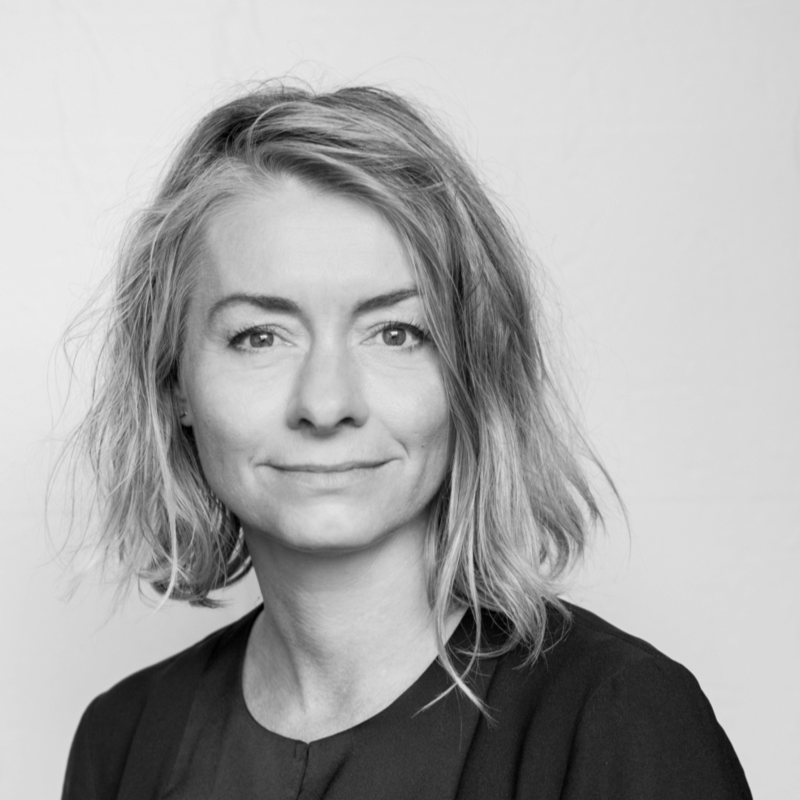
Waterscapes of value
Katrina Wiberg is a landscape architect with focus on climate adaptation in relation to water. Wiberg works with waterscapes (precipitation, groundwater, sea level rise) with a departure in landscape-based readings and strategies for climate adaptation in urban landscapes, and her PhD project was about rainwater and multiple benefits via climate adaptation. Wiberg is one of the researchers behind the 2023 Venice Biennale exhibit Coastal Imaginaries in the Danish Pavilion, addressing global challenges in the form of how to plan and protect coasts from rising seas and storm surges. Wibergs work goes beyond the protection strategies, addressing accommodation, retreat, land-use, and other strategies to face future water situations.
We were building our problems faster than we could solve them.
The connection between the built environment and the landscape
Early in her architecture career, Wiberg realized that, as a practitioner, one is most often not allowed to go beyond the designated site. So, it wasn’t a matter of not considering water issues, but that it was not possible in the design process limited to the scale of the plot, to plan with a holistic approach to the landscape character was an accumulating challenge:
– Even if you adapted a place locally, something could change upstream, resulting in a flooding downstream. We were building our problems faster than we could solve them. This changed my focus. How can we show the connection between the built environment and the landscape? The fastest urban development globally is taking place in coastlands.
Katrina Wiberg observed that most coastal cities have been looking to protect themselves from storm surges, while failing to address sea level rises. In her work, visualization of landscape based- and future coastal conditions is an important aspect of addressing the actual situation. Together with colleagues at Danish Technical University DTU, Aarhus School of Architecture, and in collaboration with University of Copenhagen KU collaborated on the research project Cities and the rising seas – new solutions spaces, that was a part of the Venice Biennale exhibition. The publication The Little Blue Atlas by AAA, visualized conditions in the form of maps show the result of investigations on the future relation between sea, coastal city and inland in the context of sea-level rise.
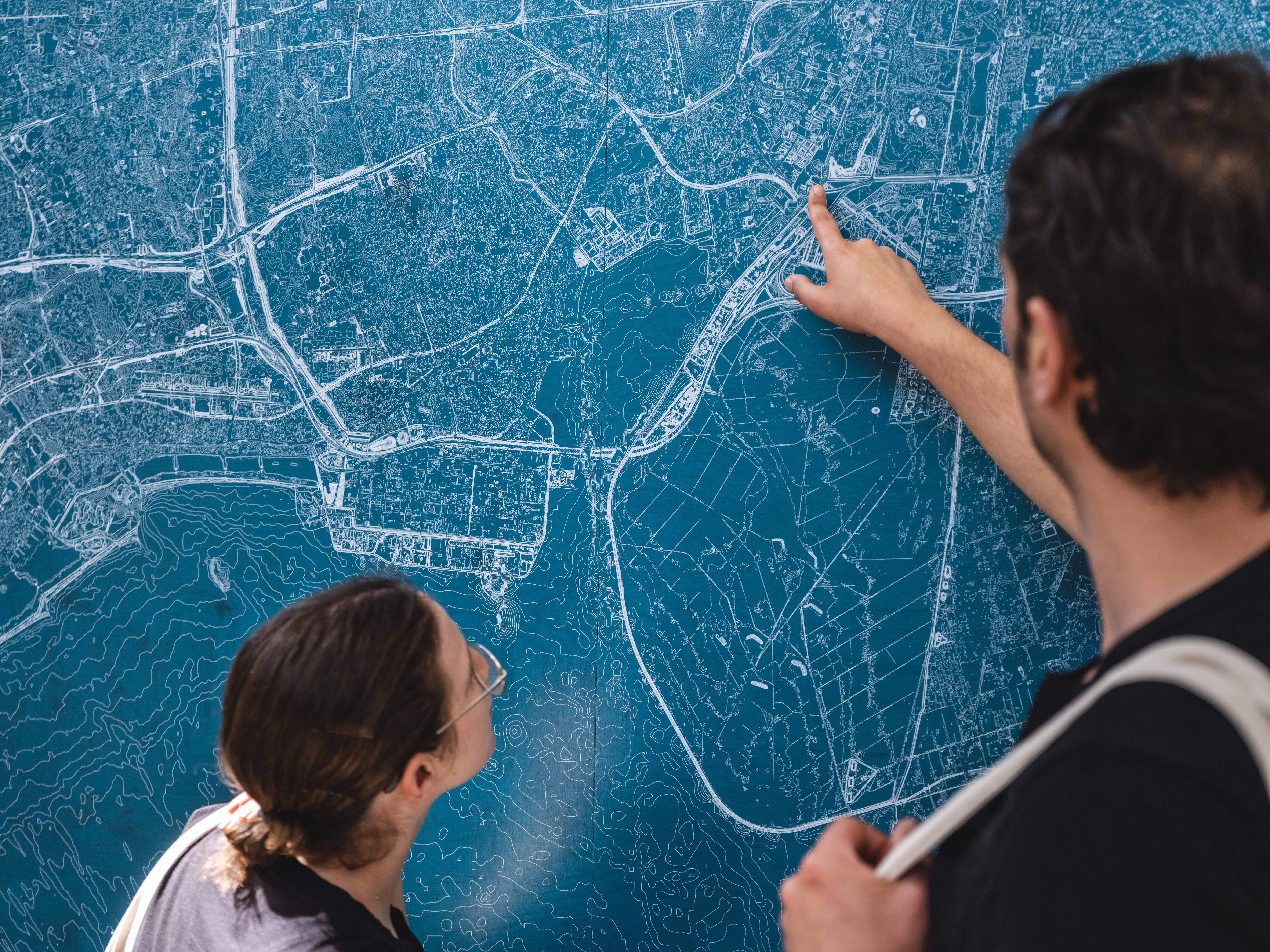
From the exhibition Coastal Imaginaries in The Danish Pavilion
– The notion of the coast as a “fixed line” may be misleading. It is a zone, and it has always been moving, but with climate change, change happens faster. We are looking at coastal cities of the future and what is happening at different sea level scenarios. Coastal cities might be aware of their relationship with water, but in Denmark, as in many other countries, public knowledge is not very high about how the watershed and inland water bodies influence the coastal areas and how cities are interdependent on the dynamics between backlands water and the sea. In the book, we explore how to visualize and map interdependencies between inland and coastal cities, coastal habitats, human and non-human, exemplified via Natura2000 protected areas.
The need to increase knowledge of coastal cities
There is a lot of work to be done in increasing the knowledge base about the intermediary phases of the landscapes and cities in relation to the uncertainty provided by sea level rise and changing waterscapes, and plenty more to do as actual adaptation, Wiberg points out:
– From a national, to regional, to municipal to city scale and down to the individual level, we are transforming everything around us, now change from natural forces is increasing speed. We have added so much to the land – buildings, car parking, infrastructure. A lot is being built in harbor sites of Danish coastal cities, but what do we build on this edge to the future? We have studied 54 cases around Denmark, and the tendency is that buildings are constructed in flood risk zones, also since the EU Flood Risk Directive was enforced in 2011 and the first municipal climate adaptation plans of 2013.
– We found that in 37 of 54 cases, there are new buildings or plans for urban development in the form of residential housing and public buildings in flood risk zones of coastal cities. Some of our cases are very small towns of about 6 000 inhabitants, but they seem to be built in the image of Copenhagen or Aarhus or other large cities. However, the capacities to handle the risks are much smaller than in the bigger cities.
Throughout the case study, Wiberg and the research team have observed that most communities would benefit from developing in a more contextualized way.
– A number of adaptation projects are initiated, in the form of retrofitting of existing urban and suburban contexts, however, most strategies focus on protection using sea walls and so forth. Still, in many of the cities that we studied, there are possibilities of using nature-based solutions as buffers for water and implementing blue-green structures accommodating ecosystems and also providing recreational and multifunctional use. I see the possibilities for integrating contextualized landscape readings as the base for climate adaptation as a low hanging fruit, with the potential of adding spatial qualities while adapting to the new reality, in the context of everyday life. The objective is to see water and adaptation as an opportunity to create multiple benefits in urban landscapes, attending to both human and non-human species.
The objective is to see water and adaptation as an opportunity to create multiple benefits in urban landscapes, attending to both human and non-human species.
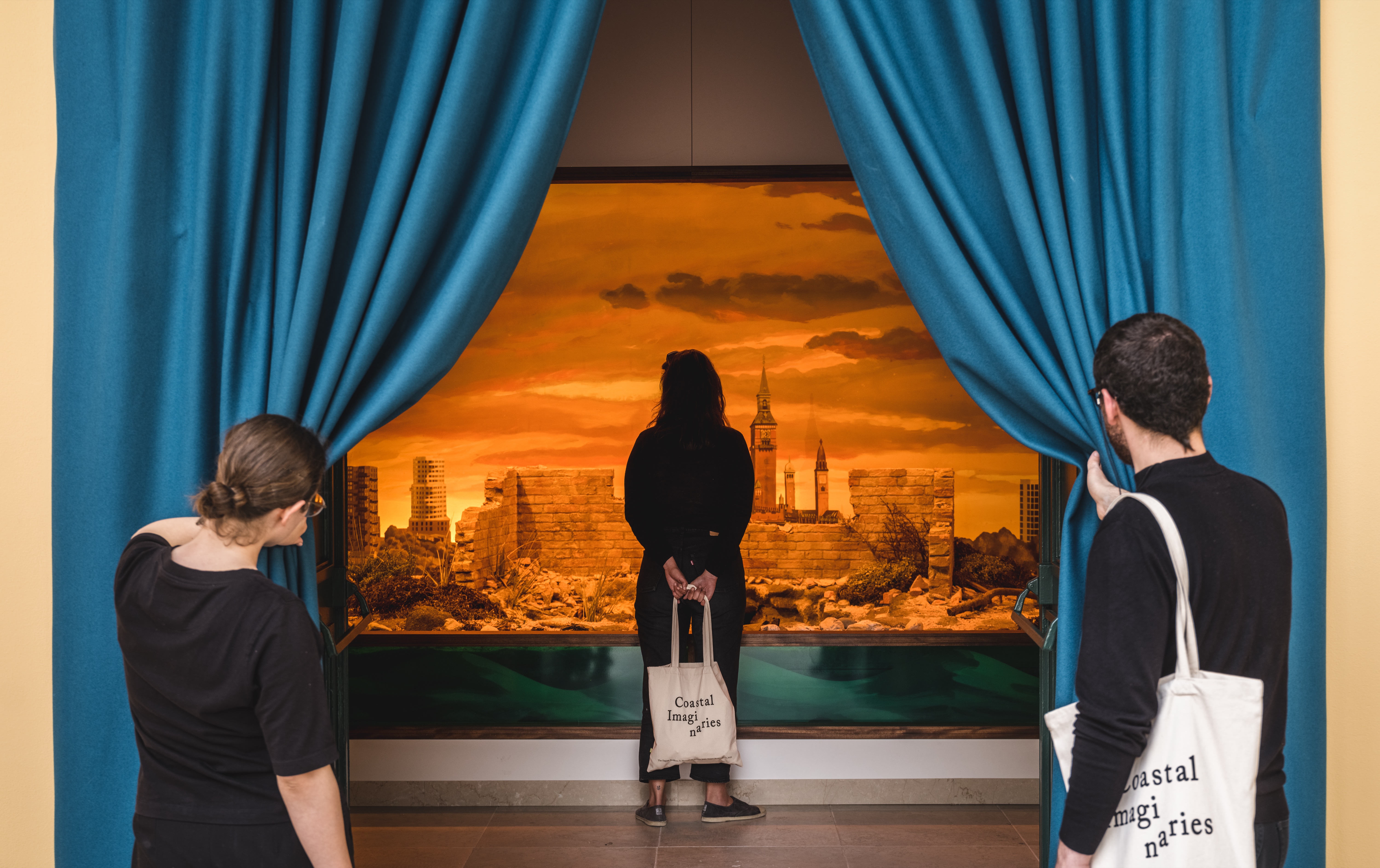
From the exhibition Coastal Imaginaries in The Danish Pavilion
A need for more collaboration across the Nordic countries
Katrina Wiberg would like to see more collaboration across the Nordic countries, in and out of the academic context, and to learn more about various local traditions of living with water.
– We have an exchange with the landscape architecture education based in Tromsø, and some collaboration with the AHO in Oslo. In Sweden, we have some contact for research purposes. We should develop more research connections in the Nordic countries. Many institutions or research projects are too small for EU funding, so a Nordic collaboration would be a way to size up in relation to available funding on EU level. As water and climate change adaptation involves many interests and fields of knowledge, we should focus on interdisciplinary and trans-sectorial collaboration.
According to Katrina Wiberg, a primary research task is to identify and suggest solutions to conflicts of interests in land use.
– Land use and land ownership sometimes stand in conflict with water situations. It is complex, but possible, to assess how changes in land use and changing waterscapes can co-develop over time. In our research, we show that different land areas should have different functions in order to handle the dynamics of water better, but of course there are a lot of interests for every piece of land. We need to understand the difference between a shortsighted scenario, like building on harbor fronts to attract new residents, and a more resilient way of preventing future risks and thus, costs, like adapting our land use and structures to the prospect of rising sea levels.
Waterscapes as a driver of new practices
A change of attitude in our lives and new practices will be required, as e.g. we cannot expect the same crop yield on the exact same land in the future. This calls for new crops and practices in agriculture too. In terms of building at the harbor front, and costs, interestingly, insurance companies are front runners too in these questions, being among the first to analyze land use from the perspective of ownership.
According to Katrina Wiberg, the climate seems to be changing with a pace that calls for progress on climate adaptation. This progress may be encouraged by an awareness of what qualities can be added to our everyday lives.
– Our state funded opportunities add some progress, yet it is slow because the changes are often voluntary. Climate change is a matter of uncertainty, to which we have to respond through action. My point of departure is landscape architecture, and the aim is to develop an awareness of waterscapes as a driver of new practices, multiple benefits, hybrid land-uses, to us and other species, in urban landscapes.